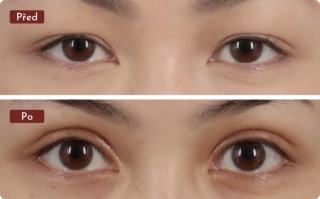Plastic surgery for Asian eyelids
The aim of this specialized surgery of the upper eyelids is not only their rejuvenation but mainly to accentuate and achieve a wider and more open-eyed look.
Frequently Asked Questions
What does the procedure involve?
This procedure is performed with a thin incision along the upper eyelid to create a fold.
There are two main surgical techniques used to create a double eyelid fold. Asian eyelid surgery is highly specific and tailored to natural differences in anatomy, personal goals, and preferences.
When selecting the most suitable method, individual eyelid characteristics should be taken into account, such as the amount of excess skin, eyelid heaviness, asymmetry, ptosis, eye shape, and the desired type of double eyelid. The recommended surgical approach to achieve your specific goals and desired outcomes will be thoroughly discussed during the initial consultation.
Who is the procedure suitable for?
The procedure is suitable for clients with Asian-type eyes who desire a more open and refreshed appearance of their eyes.
What to do before the surgery?
Before upper eyelid plastic surgery, a preoperative examination is necessary, which will be provided by your general practitioner. This examination includes a blood test, including clotting values, laboratory determination of liver function values, mineral content, and so on. Assessment of heart function is necessary only for procedures under general anesthesia, or for patients over 40 years of age and patients with heart problems.
Before the surgery, we do not recommend taking medications such as Acylpyrin, Alnagon, Aspirin, Mironal, which can cause increased bleeding during and after the surgery. Clients taking blood thinners (such as Warfarin) should consult their treating physician about their temporary discontinuation.
What to do on the day of the operation?
On the day of the surgery, you will arrive at the clinic at the agreed time. You will bring your pre-operative examination, which must include a statement from your general practitioner regarding your fitness for the procedure. The pre-operative examination must not be older than 14 days prior to the surgery.
How does the plastic surgery proceed?
After careful outlining, a surgical incision is made in such a way that it is hidden in the skin fold of the eyelid, and the scar remains covered under natural skin folds in the orbitopalpebral sulcus of the upper eyelid. Subsequently, excess skin and a fine strip of orbicularis muscle are removed. After dissection of the fat prolapses, the wound is closed with careful, fine intradermal sutures. Finally, special dressings are applied to the wound.
Upper eyelid surgery takes about an hour.
What to do after the surgery?
After the plastic eyelid surgery, the wounds are covered with a thin plaster. The client leaves immediately after the procedure without significantly impaired vision. However, they should not drive a car, so we recommend that they arrange for a companion to take them home. Before leaving, the client will be thoroughly instructed on postoperative care at home.
During the postoperative period, it is advisable to follow a rest regime and apply cooling compresses to prevent the development of larger swelling and bruises. The most significant swelling disappears after thorough cooling within a few days and usually completely resolves within one to two weeks. It is recommended to sleep with the head elevated for a week and limit physical activity that could raise blood pressure.
Exact instructions
During the first 24 hours, it is recommended that you apply cold compresses (cooling gels) over sterile covering in 30-minute intervals with 30-minute breaks. You do not need to apply them overnight.
On the second day, keep the thin elastic bandages attached to the skin. It's important that the bandages do not get wet for 7 days, and continue to ice them with a flattened tissue so that the bandages remain dry.
On the third day after surgery, it is still advisable to use ice, but not in such great intensity. Swelling and bruising on the eyelids occur after surgery and may persist for 2-3 weeks. It's natural, so don't worry.
On the 7th day after surgery, you will come to the clinic to have the stitches removed. The bandages on the eyelids must remain in place until the stitches are removed. If the bandage comes off earlier, you should come to the clinic for reapplication. After the stitches are removed, icing is no longer necessary.
On the 13th day after surgery, you can start with gentle scar massage. Gently press the tip of your finger onto the scar, apply pressure for about 30 seconds, then move your finger to another area of the scar. Massage the scar several times a day in this way. You can use a fragrance-free cream or olive oil.
After the operation, you should avoid exposure to sunlight for 2-3 months and it is advisable to protect your eyelids with a high-factor sunscreen.
The inability to work or work incapacity.
The client can start performing a light, so-called office job from the 3rd day after the operation, but they should expect significant swelling and bruising, which will persist for approximately 1-2 weeks. The final result of the upper eyelid surgery is evaluated after 4-8 weeks when the swelling has completely subsided, and the scar is almost invisible.
